Clapham Junction railway station
Clapham Junction railway station (/ˈklæpəmˈdʒʌŋkʃən/[3]) is a major railway station and transport hub near St John's Hill in south-west Battersea in the London Borough of Wandsworth. It is 2 miles 57 chains (2.71 mi; 4.37 km) from London Victoria and 3 miles 74 chains (3.93 mi; 6.32 km) measured from London Waterloo;[4] it is on both the South Western main line and Brighton main line as well as numerous other routes and branch lines passing through or diverging from the main lines at this station. Despite its name, Clapham Junction is not located in Clapham, a district situated approximately 1 mile (1.6 km) to the south-east.
| Clapham Junction | |
|---|---|
 South West (Brighton Yard) entrance | |
 Clapham Junction Location of Clapham Junction in Greater London | |
| Location | Battersea |
| Local authority | London Borough of Wandsworth |
| Managed by | Network Rail |
| Station code | CLJ |
| DfT category | B |
| Number of platforms | 17 |
| Accessible | Yes[1] |
| Fare zone | 2 |
| Cycle parking | Yes – external |
| Toilet facilities | Yes – behind gateline |
| National Rail annual entry and exit | |
| 2014–15 | |
| – interchange | |
| 2015–16 | |
| – interchange | |
| 2016–17 | |
| – interchange | |
| 2017–18 | |
| – interchange | |
| 2018–19 | |
| – interchange | |
| Key dates | |
| 2 March 1863 | Opened |
| Other information | |
| External links | |
| WGS84 | 51.4646°N 0.1705°W |
Routes from London's south and south-west termini, Victoria and Waterloo, funnel through the station, making it the busiest in Europe[5] by number of trains using it: between 100 and 180 per hour except for the five hours after midnight. The station is also the busiest UK station for interchanges between services,[6] and the only railway station in Great Britain with more interchanges than entries or exits.[7]
History
On 21 May 1838 the London and Southampton Railway became the London and South Western Railway (L&SWR), and opened its line from Nine Elms as far as Woking.
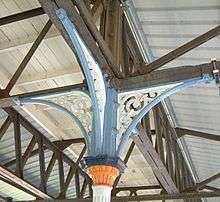
The second line, initially from Nine Elms to Richmond, opened on 27 July 1846. Nine Elms was replaced in 1848 as the terminus by Waterloo Bridge station, now Waterloo. The line to Victoria opened by 1860. Clapham Junction opened on 2 March 1863, a joint venture of the L&SWR, the London, Brighton and South Coast Railway (LB&SCR) and the West London Extension Railway (WLER) as an interchange station for their lines.[8]
The railway companies, to attract a middle- and upper-class clientele, seized the unindustrial parish calculating that being upon the slopes of Clapham's plateau would only re-inforce this distinction, leading to a long-lasting misunderstanding that the station is in Clapham.[9][10]
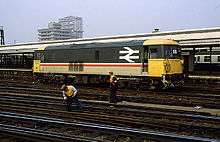
Discontinued proposals
A £39.5 million planning application from Metro Shopping Fund was withdrawn before governmental planning committee consideration on 20 May 2009.[n 1]
A 'Heathrow Airtrack' to reduce the 95-minute journey by tube and Gatwick Express to Gatwick and unite the Great Western Main Line with Heathrow, Gatwick and the South Western Main Line was cancelled in 2011 following improvements to the 2005-built Heathrow Connect track from Hayes and Harlington and practical impediments, such as pressure for continued high-frequency services on the three deemed-'entrenched' semi-fast and slow services between Clapham Junction and Staines. Overground, the change would have been at Clapham Junction.[11]
Incidents and accidents
Clapham rail disaster
On the morning of 12 December 1988, two collisions involving three commuter trains occurred slightly south west of the station due to a defective signal. Thirty-five people died and more than 100 were injured.[12]
Track bombing
On the morning of 16 December 1991, a bomb ripped through tracks on one of the station's platforms, causing major disruption to the rail network. The Provisional Irish Republican Army (IRA) claimed responsibility.[13]
The Junction
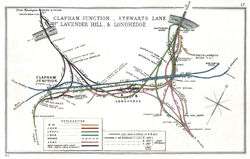
The station is named Clapham Junction because it is at the junction of several rail lines. The name is not given to any rail junction near the station which, without end-on intercompany junctions, are:
- Falcon Junction at the south end of the station, where the West London Line (WLL) joins the Brighton Slow Lines
- Ludgate Junction at the eastern end of the Windsor Line platforms to the WLL
- Latchmere SW Junction connecting the WLL to the Windsor lines at Ludgate Junction.
- Latchmere Main Junction connecting the WLL to the Brighton Line at Falcon Junction.
- West London Extension Junction and Junction for Waterloo, relaid for Eurostar empty-stock moves from the Windsor Lines to the WLL.
- Pouparts Junction where the low-level and high-level approaches to Victoria split.
The station today
Railways around Clapham Junction | |||||||||||||||||||||||||||||||||||||||||||||||||||||||||||||||||||||||||||||||||||||||||||||||||||||||||||||||||||||||||||||||||||||||||||||||||||||||||||||||||||||||||||||||||||||||||||||||||||||
|---|---|---|---|---|---|---|---|---|---|---|---|---|---|---|---|---|---|---|---|---|---|---|---|---|---|---|---|---|---|---|---|---|---|---|---|---|---|---|---|---|---|---|---|---|---|---|---|---|---|---|---|---|---|---|---|---|---|---|---|---|---|---|---|---|---|---|---|---|---|---|---|---|---|---|---|---|---|---|---|---|---|---|---|---|---|---|---|---|---|---|---|---|---|---|---|---|---|---|---|---|---|---|---|---|---|---|---|---|---|---|---|---|---|---|---|---|---|---|---|---|---|---|---|---|---|---|---|---|---|---|---|---|---|---|---|---|---|---|---|---|---|---|---|---|---|---|---|---|---|---|---|---|---|---|---|---|---|---|---|---|---|---|---|---|---|---|---|---|---|---|---|---|---|---|---|---|---|---|---|---|---|---|---|---|---|---|---|---|---|---|---|---|---|---|---|---|---|
| |||||||||||||||||||||||||||||||||||||||||||||||||||||||||||||||||||||||||||||||||||||||||||||||||||||||||||||||||||||||||||||||||||||||||||||||||||||||||||||||||||||||||||||||||||||||||||||||||||||
Each day more than 2,000 trains, over half of them stopping, pass through the station, more than through any other station in Europe.[14] At peak times up to 200 trains per hour pass through of which 122 stop. It is not the busiest station by number of passengers, most of whom (about 430,000 on a weekday, of which 135,000 are at rush hours) pass through. Interchanges make some 40% of the activity and on that basis too it is the busiest station in the UK.[15]
In 2011 the station had three entrances, all with staffed ticket offices, though only the south-east entrance is open 24 hours a day. The most heavily used of the three, this leads from St John's Hill via a small indoor shopping centre into a subway some 15 feet (4.6 m) wide, that connects to the eastern ends of all platforms.
The north entrance, which has restricted opening hours, leads from the Winstanley Estate on Grant Road to the same subway.[16][17] The subway is crowded during rush hours, with the ticket barriers at the ends being pinch points.
The south-west entrance, also known as the Brighton Yard entrance, as the buildings still bear signage for the London Brighton and South Coast Railway, is of a more traditional appearance, with a Victorian station building set at the back of a large forecourt. This entrance leads to a very wide covered footbridge, which joins the western ends of all platforms. This entrance includes cycle parking and a taxi rank. It was re-opened in May 2011 as part of a wider programme of access improvements that included installing lifts to the platforms.[18]
There are public and disabled toilets at the south-west entrance. There are refreshment kiosks in the subway, on the footbridge and on some platforms; and a small shopping centre, including a small branch of Sainsbury's supermarket, in the south-east entrance.
British Transport Police maintain a neighbourhood policing presence,[19] whereas the Metropolitan Police Service and the part-Transport for London funded Safer Transport Command provides a police presence in the area outside the station.
9 December 2012 saw the opening of a new platform for the East London Line, creating an orbital railway around inner London.[20]
Overcrowding is most frequent in the often convenient but narrow cross-platform subway. Using this rather than the wide, elegant flying concourse for interchange, a visitors' eyes assessment of fabric and environment listed Clapham Junction in the most needy 10% of Department for Transport category B stations.
Platforms

The station has 17 platforms, 1 to 17:
- Platforms 1 and 2 are northeast-facing bay platforms, used by the London Overground services to and from Highbury & Islington.[21] Usually, platform 1 is served by trains via Willesden Junction on the West London line, while platform 2 is used by services via Canada Water on the South London line, although this usage can be reversed.
- Platforms 3 to 6 are through platforms used by South Western Railway services going to or from Putney and beyond.[21]
Sidings leading into railway sheds at the west of the station are located between platforms 6 and 7.[21]
- Platforms 7 to 11 are through platforms used by South Western Railway services going to or from Wimbledon and beyond. Some long-distance services (from places such as Portsmouth Harbour or Weymouth) that do not call at the station also pass through these platforms.[21]
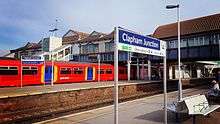
- Platforms 12 to 15 are through platforms used by Southern services that start or terminate at London Victoria. The non-stopping Gatwick Express services also pass through these platforms.[21]
- Platforms 16 and 17 are through platforms used by Southern services on the West London Line (to or from Watford Junction or Milton Keynes Central). During emergency engineering works, these platforms can also be used by some London Overground services to and from Willesden Junction.[21]
Services
All South Western Railway services from Waterloo pass through the station, as do Southern and Gatwick Express trains from Victoria. The West London line and East London line services of London Overground have Clapham Junction as one of the termini.
The typical off-peak service of more than 120 trains an hour comprises:
- 35 to London Waterloo
- 22 to London Victoria
- 1 to Alton
- 1 to Basingstoke (slow)
- 2 to Brighton
- 2 to Caterham via Norbury
- 2 to Chessington South
- 1 to Dorking via Sutton
- 2 to Dorking via Wimbledon
- 1 to East Croydon via Norbury
- 2 to East Grinstead via Oxted
- 1 to Epsom Downs
- 2 to Epsom via Hackbridge
- 1 to Epsom via Norbury
- 1 to Exeter St Davids via Salisbury
- 2 to Guildford via Cobham & Stoke d'Abernon
- 2 to Guildford via Epsom and Leatherhead
- 2 to Hampton Court via Surbiton
- 1 to Haslemere
- 4 to Highbury & Islington via Denmark Hill[22]
- 1 to Horsham via Sutton and Dorking
- 1 to Littlehampton and Eastbourne, dividing at Haywards Heath
- 2 to London Bridge via Crystal Palace
- 2 to London Waterloo by the Hounslow Loop via Brentford, Hounslow and Richmond
- 2 to London Waterloo by the Hounslow Loop via Richmond, Hounslow and Brentford
- 2 to London Waterloo by the Kingston Loop via Wimbledon, Kingston and Richmond
- 2 to London Waterloo by the Kingston Loop via Richmond, Kingston and Wimbledon
- 1 to Milton Keynes Central via Kensington Olympia and Watford Junction
- 1 to Ore and Littlehampton, dividing at Haywards Heath
- 1 to Poole (slow)
- 1 to Portsmouth and Southsea via Haslemere
- 1 to Portsmouth Harbour and Bognor Regis, dividing at Horsham
- 2 to Reading via Wokingham
- 1 to Reigate
- 2 to Shepperton via Wimbledon
- 1 to Southampton Central and Bognor Regis, dividing at Horsham
- 2 to Sutton via Norbury
- 2 to Weybridge via Brentford, Hounslow and Staines
- 1 to Weymouth
- 4 to Willesden Junction, of which 2 continue to Stratford[23]
- 2 to Windsor and Eton Riverside
- 2 to Woking (slow)
During peak hours on weekdays express services on the South Western Main Line and outer suburban services to Alton and Basingstoke typically do not stop at the station.
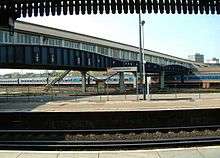
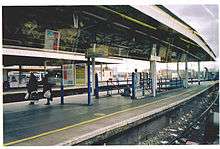
| Preceding station | Following station | |||
|---|---|---|---|---|
| London Waterloo | South Western Railway South Western Main Line West of England Main Line |
Woking or Basingstoke | ||
| South Western Railway Waterloo to Basingstoke Alton Line |
Wimbledon or Surbiton | |||
| Vauxhall | South Western Railway Waterloo to Woking Mole Valley Line Kingston Loop via Wimbledon Shepperton Branch Hampton Court Branch New Guildford Line |
Earlsfield | ||
| London Waterloo or Vauxhall |
South Western Railway Waterloo to Reading |
Richmond | ||
| Vauxhall | South Western Railway Waterloo to Reading |
Putney | ||
| Queenstown Road (Battersea) |
South Western Railway Kingston Loop via Richmond Hounslow Loop |
Wandsworth Town | ||
| London Victoria | Southern Brighton Main Line |
East Croydon | ||
| London Victoria | Southern Oxted Line |
East Croydon | ||
| Imperial Wharf | Southern West London Route |
Wandsworth Common | ||
| Battersea Park | Southern London Victoria to London Bridge |
Wandsworth Common | ||
| Southern Victoria to East Croydon |
||||
| Southern London Victoria to Sutton via Crystal Palace |
||||
towards Dalston Junction | South London Line | Terminus | ||
| Terminus | West London Line | |||
| Proposed Future Development | ||||
| Preceding station | Following station | |||
Balham | Crossrail Line 2 | Chelsea |
||
| Historical railways | ||||
| Terminus | West London Line | Battersea | ||
Future proposals
In 2007 the alignment of one of the two variants of Crossrail 2, that via the station rather than Putney and Wimbledon, was safeguarded. The Department for Transport and Transport for London continue to discuss proposal for a Clapham Junction Northern Line extension and its London Underground alignment has been legally reserved through Battersea Park,[24] and would connect Clapham Junction to the London Underground for the first time.
Government and Network Rail funding for in the early 2010s of £50 million of improvements was granted.[25] This comprised an upgrade to the main interchange: new entrances and more retail.[26]
In a Network Rail study it is proposed that platform 0 could reopen for 8-car operations of the West London Line.[27]
Connections
London Buses routes 35, 37, 39, 49, 77, 87, 156, 170, 219, 295, 319, 337, 344, 345, 639, 670, C3 and G1 and night routes N19, N31, N35 and N87 serve the station.[28][29]
Notes and references
Notes
- The 2009 Metro Shopping company plan included a new entrance on St John's Hill, the straightening and extension of platforms 15 to 17, more ticketing facilities, step-free access to all platforms by 2011, a new step-free entrance on Grant Road, and a new 'high street' from St John's Hill to Falcon Road with retail space and arthouse cinema. Profitable immediate funding was planned via radical height 42-storey residential buildings above the station.
References
- National Rail: Clapham Junction Accessed 7 August 2011
- "Station usage estimates". Rail statistics. Office of Rail Regulation. Please note: Some methodology may vary year on year.
- "clapham-junction - Definition, pictures, pronunciation and usage notes - Oxford Advanced Learner's Dictionary at OxfordLearnersDictionaries.com". www.oxfordlearnersdictionaries.com. Retrieved 24 April 2019.
- Yonge, John (November 2008) [1994]. Jacobs, Gerald (ed.). Railway Track Diagrams 5: Southern & TfL (3rd ed.). Bradford on Avon: Trackmaps. map 2L. ISBN 978-0-9549866-4-3.CS1 maint: ref=harv (link)
- Great British Railway Journeys (Series 4, Episode 7): "Woking to Clapham Junction" BBC Two, 15 January 2013
- Office of Rail Regulation, Station Usage Estimates 2011–12
- "Estimates of Station Usage 2017-18" (PDF). Office of Rail and Road. 11 December 2018. Retrieved 31 December 2018.
- The west London Railway and the W.L.E.R, H.V.Borley & R.W.Kidner, 1981 reprint, The Oakwood Press, Usk Monmouthshire. ISBN 0-85361-174-2
- Year's Art, published 1922, London, p. 500
- Directory of British Architects, 1834–1914: Vol. 2 (L-Z) A. Brodie (ed), 2001, Continuum, London, p.12
- "Heathrow Airtrack Waterloo rail link shelved by BAA". BBC News London. 11 April 2011. Retrieved 29 December 2011.
- "1988: 35 dead in Clapham rail collision". BBC On This Day. British Broadcasting Corporation. Retrieved 11 July 2017.
- O'Mara, Richard. "British workers, shoppers brave IRA bomb wave with dogged determination". baltimoresun.com. Retrieved 24 April 2019.
- "Great British Railway Journeys (Series 4, Episode 7): Woking to Clapham Junction" BBC2, UK TV Channel, 15/01/13
- Delta Rail, 2008–09 station usage report, Office of the Rail Regulation website
- "Winstanley Estate on Grant Road Clapham Junction Entrance 1".
- "Winstanley Estate on Grant Road, Clapham Junction Entrance 2".
- Route Plans 2007 – Route 3 – South West Main line Archived 29 February 2008 at the Wayback Machine published by Network Rail, 2007 – See page 20
- "British Transport Police, London South Area". Archived from the original on 21 December 2008. Retrieved 14 December 2008.
- Majumdar, Debabani (10 December 2012). "Outer London rail orbital opens". Retrieved 24 April 2019 – via www.bbc.co.uk.
- "Detailled London transport map (track, depot, ...)". cartometro.com. Retrieved 24 April 2019.
- "Highbury & Islington to West Croydon/Clapham Junction timetable" (PDF). Retrieved 24 April 2019.
- Richmond/Clapham Junction to Stratford timetable Archived 13 February 2015 at the Wayback Machine
- Clapham Junction next for Northern Line says London Assembly member Wandsworth Guardian
- "£50m revamp for 'worst stations'". BBC News. 17 November 2009. Retrieved 17 November 2009.
- Chris Green & Sir Peter Hall, Better Rail Stations Archived 22 November 2009 at the Wayback Machine, November 2009
- "Clapham Junction Station – Bus Station 1". Retrieved 24 April 2019.
- Matters, Transport for London | Every Journey. "Clapham Junction Station". Transport for London. Retrieved 24 April 2019.
External links
| Wikimedia Commons has media related to Clapham Junction railway station. |
- Network Rail Details
- Short History of Clapham Junction prepared by Wandsworth Council, and from which much of the information in the history section of this entry is sourced
- 1988: 35 dead in Clapham rail collision BBC News report on the 1988 train collisions
- Local news website
- Yes, Clapham Junction is that bad. The sun shone, but the roof still leaks, Zoe Williams, The Guardian 18 November 2009
- Winchester, Clarence, ed. (4 October 1935), "Clapham Junction", Railway Wonders of the World, pp. 1129–1132, description of the station in the 1930s